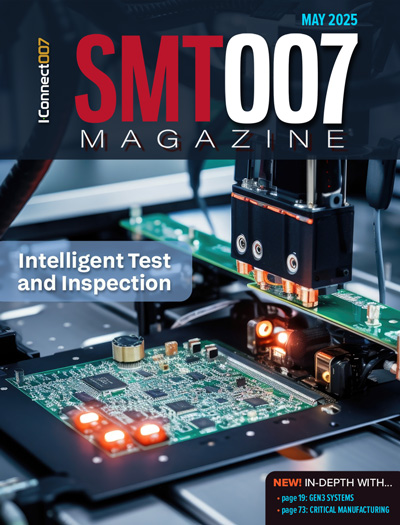-

-
News
News Highlights
- Books
Featured Books
- smt007 Magazine
Latest Issues
Current Issue
What's Your Sweet Spot?
Are you in a niche that’s growing or shrinking? Is it time to reassess and refocus? We spotlight companies thriving by redefining or reinforcing their niche. What are their insights?

Moving Forward With Confidence
In this issue, we focus on sales and quoting, workforce training, new IPC leadership in the U.S. and Canada, the effects of tariffs, CFX standards, and much more—all designed to provide perspective as you move through the cloud bank of today's shifting economic market.

Intelligent Test and Inspection
Are you ready to explore the cutting-edge advancements shaping the electronics manufacturing industry? The May 2025 issue of SMT007 Magazine is packed with insights, innovations, and expert perspectives that you won’t want to miss.
- Articles
- Columns
- Links
- Media kit
||| MENU - smt007 Magazine
JTAG Visualizer Update Adds Features for Faster Debug
January 16, 2018 | JTAG TechnologiesEstimated reading time: 3 minutes
The speed of change in the electronics industry is rapidly accelerating. The direction in which the industry moves is constantly shifting and it needs participation, see you in San Diego. JTAG Technologies is excited to showcase here in San Diego the latest version of its acclaimed Visualizer graphical viewing tool for board (PCB) layouts and schematics. Allowing users to assess fault coverage data and pin-point production test faults in a snap.
Wide-ranging CAD support
With its wide range of CAD (EDA) tool import filters Visualizer is the number one choice for professional boundary-scan development and test engineers. Users can import schematic data direct from Mentor (Pads, DxDesigner, Capture) Cadence, Altium and Zuken tools as well as board layout information in ODB++ and a dozen other vendor specific formats.
JTAG Maps
Introduced in this version of Visualizer, the new Maps feature offers a basic test-accessibility view by a simple click of the mouse. The view can easily be fine-tuned by adding just a few key component descriptions to a look up table. What’s more using customisable colors to indicate test coverage levels or access types, a color-coded schematic can be displayed or printed. Once the design has been optimized for boundary-scan test coverage and committed to layout, final application development can begin in the JTAG ProVision developer tool.
Additional new features
Visualize on (Test) Fail -When running a test sequence or during test debug within ProVision it is now possible to view all failing circuit nets on a schematic view, a layout view or both – automatically. This feature is ideal for small-scale production systems where the test operator is also responsible for fault diagnosis and rework.
Locate Next – during fault-finding the ‘locate next’ feature allows the user to track the course of a net connection through the layers of a PCB layout or the sheets of a schematic.
Multiple Color Themes - users can now define multiple color themes for distinguishing different net classifications e.g. for percentage fault coverage in schematics or fault nets in layouts to aid in debug and repair
View through layers - a highlighted fault net, perhaps as a result of a detected board connection fault, can now be viewed along its entire path and as it changes course through the board (pcb) layers.
Add notes – A note can be added anywhere at a fixed position on the schematic or layout. Ideal for conveying additional information about test processes or passing design details back and forth between users.
Peter van den Eijnden, MD JTAG Technologies, comments ‘ Our impressive enhancements to Visualizer come as a result of our commitments to customer liaison and also our work with various 3rd parties such as the EDA vendors’.
Another JTAG Highlight at APEX 2018 - ATE Integration: Simple and effective improvement of test coverage
Clients need to improve the overall test coverage of their assembled boards. It’s easy. Clients can simply combine their JTAG Technologies boundary-scan tools with todays’ existing automatic test equipment (ATE). JTAG works with any vendor of in-circuit testers (ICT), flying probes (FPT) or functional testers (FT).
ATE integration is completely trouble free and merely involves adapting execution software to operate in the specific ATE environment. In many cases we at JTAG develop dedicated, customized versions of the boundary-scan controllers or pods. This simplifies mechanical integration and preserves signal integrity.
Our experts will discuss the level of integration variation according to your needs.
About JTAG Technologies
JTAG Technologies is a market leader and technology innovator of boundary-scan software and hardware products and services. The company was the first to bring to the market such important advances as automated test generation, automated fault coverage analysis, automated flash and PLD programming via boundary-scan, and visualized boundary-scan analysis. Its customers include world leaders in electronics design and manufacturing such as Bae, Ericsson, Flextronics, Honeywell, Medtronic, Motorola, Philips, Raytheon, Rockwell-Collins, Samsung, and Sony. Its innovative boundary-scan products provide test preparation, test execution, test result analysis and in-system programming applications. With an installed base of over 9000 systems worldwide, JTAG Technologies serves the communications, medical electronics, avionics, defence, automotive, and consumer industries with offices throughout North America, Europe and Asia. JTAG Technologies headquarters are located in Eindhoven, The Netherlands. For more information, click here.
Suggested Items
Knocking Down the Bone Pile: Addressing End-of-life Component Solderability Issues, Part 4
07/15/2025 | Nash Bell -- Column: Knocking Down the Bone PileIn 1983, the Department of Defense identified that over 40% of military electronic system failures in the field were electrical, with approximately 50% attributed to poor solder connections. Investigations revealed that plated finishes, typically nickel or tin, were porous and non-intermetallic.
Meet the Author Podcast: Martyn Gaudion Unpacks the Secrets of High-Speed PCB Design
07/10/2025 | I-Connect007In this special Meet the Author episode of the On the Line with… podcast, Nolan Johnson sits down with Martyn Gaudion, signal integrity expert, managing director of Polar Instruments, and three-time author in I-Connect007’s popular The Printed Circuit Designer’s Guide to... series.
TTCI Joins Printed Circuit Engineering Association to Strengthen Design-to-Test Collaboration and Workforce Development
07/09/2025 | The Test Connection Inc.The Test Connection Inc. (TTCI), a leading provider of electronic test and manufacturing solutions, is proud to announce its membership in the Printed Circuit Engineering Association (PCEA), further expanding the company’s efforts to support cross-functional collaboration, industry standards, and technical education in the printed circuit design and manufacturing community.
Study on Resonance Mitigation in Metallic Shielding for Integrated Circuits
07/08/2025 | Maria Cuesta-Martin, Victor Martinez, Vidal Gonzalez Aguado, Würth ElektronikInherent cavity resonant modes often lead to significant degradation of shielding effectiveness, responsible for unwanted electromagnetic coupling. Cavity resonant modes of the metal shielding enclosure can produce two adverse problems: the mutual coupling among different RF modules and shielding effectiveness reduction of the metal enclosure. The cabinets serve to shield certain components from electromagnetic interference (EMI). However, these cavities present some resonance peaks at 5 GHz, making it impossible to use them at higher frequencies.
The Global Electronics Association Releases IPC-8911: First-Ever Conductive Yarn Standard for E-Textile Application
07/02/2025 | Global Electronics AssociationThe Global Electronics Association announces the release of IPC-8911, Requirements for Conductive Yarns for E-Textiles Applications. This first-of-its-kind global standard establishes a clear framework for classifying, designating, and qualifying conductive yarns—helping to address longstanding challenges in supply chain communication, product testing, and material selection within the growing e-textiles industry.


